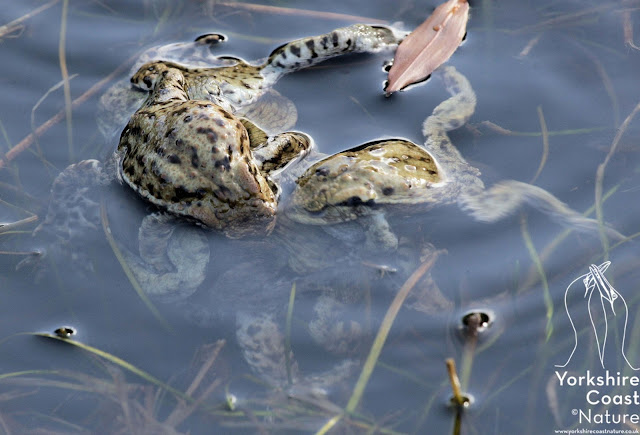If you have any spare time over the next few days why not go
and visit your local pond, chances are you will be greeted by an abundance of
common toads, a true spectacle of British springtime. Toads might not have the
charm of the first swallow or the beauty of blooming primroses but they are
indeed an equal even within natures calendar. Toads have returned to ponds in such good
numbers this year, that in the past
twenty four hours, from the time of posting this, I have counted over 1,500
adults in ponds across the recording area. Toads breed en-masse and the sudden
warmth we have seen over the past 5 days has sparked this nuptial migration
into life. A creature perhaps misunderstood with historical associations with
the devil and witchcraft, in reality toads are characters and rather docile
creatures. However they do have another less well known darker side.
Its was once believe that toads possessed a jewel within their head which gave them their bright gold eyes.
Common toads are probably the least aquatic of our native
amphibians and only enter their breeding ponds for an extremely short period of
time during the spring. Almost the entire breeding population within a given
area enters the pond over a short (usually 48 hour) period, if favourable weather
conditions persist. Animals average about 50 metres per day whilst on migration
to the pond. When toads have finished breeding they disperse widely upto 2km
into the surrounding area over the summer, before migrating back towards the
pond in the autumn (shortening the effort required during the spring).
Male common toads, sit near the surface of the pond waiting to pounce of a female, they occasionally get it wrong and grab frogs as well as fish.
Common toads favour hibernation sites within unused small
mammal burrows (i.e. woodmouse, bank vole and brown rat). Hibernation persists
until night time temperatures reach 5-6 oC, most migration also coincides
with night time rainfall, when the animals are less prone to desiccation. Toads
are primarily nocturnal in their ecology and most breeding activity, migration
and foraging occurs at night, especially in the first two hours after dusk.
The spawing period is highly impressive and usually occurs
after that of the frogs. Large numbers of animals congregate at communal
spawning ponds at this time. These populations tend to be heavily male
dominated owing to males reaching sexual maturity more quickly, arriving at the
ponds earlier and spending more time in the pond of the breeding period. Males
usually outnumber females considerable (anywhere between 2 and 10 to 1).
Females are therefore in high demand from the masses of amorous males and are quickly seized (often before
they even get to the pond). This leads to the embrace known as amplexus in
which the male clasps onto the female from behind her arms. Fertilization is
external and the stimulation of the females eggs passing over the males hind legs
causes him to release sperm and fertilize them as they are released from the
female.
The males, muscular arms are used for clasping females and wrestling other males, toads are amazingly strong creatures for their size.
If it was only this simple though... the large numbers of
males results in rather aggressive (as toads go) competition for females.
Whilst a pair are in amplexus other males will try to wrestle them apart and
mate with the female themselves. This results in TOAD BALLS!!!! in which a mass
of toads are found clasped, wrestling together around a poor female, which can occasionally
drown or be crushed. This behaviour is perhaps an evolutionary means for larger
stronger males to displace weaker smaller males from females and pass on his
genes. Certainly an entertaining event to look out for at the local pond. This fighting,
toad behaviour is used in the common toad rather than vocal calls (as we see
with natterjack). However toads still do call, the call is a high pitched
squeak rather than the deep croak of the common frog.
A toad ball, which probably contains a female buried in the middle.
Toads (like frogs) do not feed until breeding is completed,
which can put pressure on animals, resulting on natural losses during the
spring. Animals which do survive forage on invertebrates like beetles, earwigs,
spiders as well as molluscs and worms. Toads will also feed on other
amphibians, like young smooth newts, common frogs and other toads, occasionally
baby small mammals are taken from nests, as are the nestlings of ground nesting
birds. Neither of the latter two feature heavily in the diet.







No comments:
Post a Comment